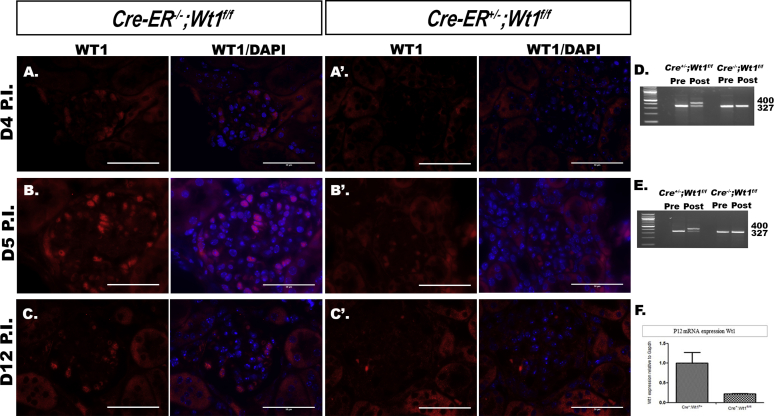Figure S1.
Wilms’ tumor 1 (Wt1) is deleted at day (D) 4, D5, and D12 postinduction (PI) of tamoxifen. (A–C′) Representative micrographs of WT1 protein expression in glomeruli following immunofluorescence labeling of CreTM−/−;Wt1f/f control mouse kidney tissue sections versus CreTM+/−;Wt1f/f mutants. Bars = 50 μm. Images were counterstained with 4′,6-diamidino-2-phenylindole (DAPI). (A,A′) D4 PI controls show WT1 protein expression as indicated by red arrows (A) in comparison to mutants, where WT1 protein expression is reduced (A′). (D) DNA expression of Wt1 PI of tamoxifen following polymerase chain reaction analysis. Recombination is present in the mutants, but no recombination is seen in controls. (B,B′) D5 PI micrographs highlighting WT1 protein expression in controls, as indicated by arrows (B), versus mutants, where no WT1 protein is observed (B′). (E) Polymerase chain reaction analysis of Wt1 genotyping PI of tamoxifen in mutants versus controls. Wt1 amplicon is reduced and recombination is shown in the mutant. (C,C′) Representative micrographs of glomeruli following immunofluorescent labeling of podocytes with WT1 in D12 PI sections. WT1 protein is present in controls, as indicated by the red arrows (C), versus mutants, where WT1 is absent (C′). (F) Quantitative real-time polymerase chain reaction graph highlighting mRNA expression of Wt1 relative to Gapdh showing a reduction of Wt1 in the mutant versus control.

